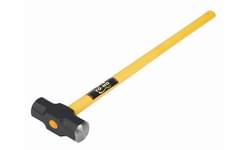




These are the most commonly used Pounding and Hammering Tools with tips on using them safely and effectively.
These are the most commonly used pounding and hammering Tools with tips on using them safely and effectively.
by Jim Schmid

These are the most commonly used Pounding and Hammering Tools with tips on using them safely and effectively.
A sledgehammer with a 6- to 8-pound head and a 3 foot-long handle is most useful for trail work. It can be used to crush rock into gravel (stone sledge) for trail repair, and for driving stakes or rebar (driving sledge) to secure waterbars and turnpikes. Because of differences in tempering, the stone and driving sledges are not interchangeable. Before swinging, you should make sure others are clear and you have a firm stance with feet spread to shoulder width and firmly planted. Even more than other striking tools, the sledge holds the potential for serious injury because of its greater, more awkward weight. Use only short controlled swings, never using all your might.
Safety tip: Sledgehammers can cause stone chips to fly. Protect yourself by wearing a hardhat, eye protection, long pants, and boots.
A single-jack (3- to 4-pound head with short handle) hammer can be used with a star drill to punch holes in rock. The single-jack can also be used to drive bridge spikes and for other jobs that are too demanding for a regular claw-hammer, but do not require the heavy-duty blows of a sledge.
Safety tip: Wear a hardhat and eye protection at all times.
Star drills are usually about a foot long and weigh a pound. They are used with single-jack hammers to punch holes in rock or open a seam or crack.
Safety tip: Wear a hardhat, gloves, and eye protection when using a star drill.
posted Sep 11, 2023
The tools shown here are those used most often by Forest Service trail crews. They are categorized into tools for sawing, chopping, grubbing, digging and tamping, pounding, and hammering, lifting and hauling, peeling and shaping, and sharpening and rehandling. Each tool is described along with helpful techniques for use and maintenance.
Tools for Trails: Measuring and Surveying Tools
posted Nov 8, 2022
Before trail builders start digging, they first have to lay the trail, flag the line, and more to ensure a grade that not only matches the terrain but also is well throughout to prevent erosion.
posted Aug 8, 2022
Let’s talk about grubbing and raking tools! You might have heard the term grubbing before, but if you’re new to trail building, it may be unfamiliar. Grubbing is when you are removing earth and topsoil. Basically digging into the first while removing vegetation in the process. Trail builders may also call this process hogging.
posted Jun 8, 2022
There are a few options for striking tools that you may see out on a project. Some like the sledge hammer will be seen more, while others may only be pulled out for special projects.
3,779 views • posted 04/13/2018